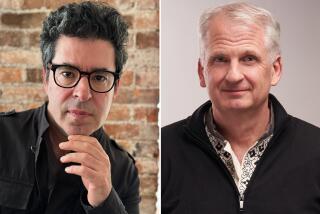The Struggle for the Soul of Spain : THE SPANISH CIVIL WAR; Revolution and Counterrevolution <i> By Burnett Bolloten (University of North Carolina Press: $59.95; 1,074 pp.) </i>
The late Burnett Bolloten’s monumental book ends with Gen. Franco’s final communique of a tragic but inevitable conflict: “Today the Nationalist troops, having captured and disarmed the Red Army, have achieved their final military objective. The war has ended.”
Soon the Spanish jails were crammed with 270,000 prisoners, mostly political detainees. The military courts were to dictate about 50,000 death sentences, of which about half were carried out. Spain had joined the European dictatorships, but she stayed aloof from the Axis.
I spent three years in Gibraltar waiting for Franco to bow through German troops that had crossed the Pyrenees. But what had been a rehearsal for an international hecatomb subsided into the uneasy sleep of a moderate tyranny.
What caused the disease that called for Franco’s scalpel? It began with the fall of the monarchy, now restored, in 1931 and the proclamation of a republic. But it found its immediate origins in the elections of February, 1936. An extensive peasantry suffered from the failure of agrarian reform. Reactionary elements, meaning mostly landholders, boycotted the new equitable regime. The gray tints of a moderate socialism were enlivened into red: It is always difficult for socialism to avoid either the recidivism into the conservative substance it replaces or its logical consummation in communism. This is why America fears even moderate socialism. In a country like Spain, which had no history of political liberalism, the slide from one authoritarian system of government to another was impossible to avoid.
The Spanish revolution meant little to an America that could be drawn out of isolationism only by an attack on its territory. It meant much to Europe, not only because it seemed prophetic of what was to come on a larger canvas but also because it showed working models of various kinds of pseudo-progressive ideologies from communism to syndico-anarchism.
It caused immense disquiet among Catholic liberals because of the treatment of the Church by the paladins of reform. “Catholic dens no longer exist,” said the anarcho-syndicalist organ Solidaridad Obrera . “The torches of the people have reduced them to ashes.” An anarchist youth manifesto proclaimed: “For the Revolution to be a fact, we must demolish three pillars of reaction: the church, the army and capitalism. The Church already has been brought to account. The temples have been destroyed by fire and the ecclesiastical crows who were unable to escape have been taken care of by the people.” The Rev. Hewlett Johnson, the so-called Red Dean of Canterbury, who interestingly reconciled Anglicanism and Marxism, denied the anticlerical atrocities, but the “Collective Letter of the Spanish Bishops,” dated July 1, 1937, claimed that 20,000 churches had been destroyed. It gave no figures for violated nuns and shot priests.
Anarchism, having no positive ideology like communism, nevertheless shared with it a joyless puritanism. In the village of Magdalena de Pulpis, tobacco and alcohol were banned. In Azuara, the collectivists closed the cafe as a “frivolous institution.” Brothels were outlawed. “The Anarchist who frequents houses of ill fame is not an Anarchist . . . He who buys a kiss puts himself on the level of the woman who sells it. Hence, an Anarchist must not purchase kisses. He should merit them.” Clearly, the Spanish beso , like the French verb baiser , is a euphemism. A highly negative approach to life was glossed as positive progress.
Spain was not permitted to fabricate a heterogeneous congeries of reformed political systems. Unification was virtually imposed by the Comintern. Moscow’s foreign representative--termed “delegates” or “instructors”--controlled Spain’s Communist leaders, sometimes under pseudonyms, which gave them the appearance of home-grown products. Boris Stefanov, a Bulgarian and friend of Lenin who had miraculously survived the purges, used the alias Moreno. His word was taken, according to Eudocio Ravines, a Peruvian Communist, “as though it were personally inspired by Stalin.”
The Slavs were not the only Red intruders. Palmiro Togliatti was to become the leader of the Italian Communist Party after World War II; in the ‘30s he was writing the speeches of Jose Diaz and that tigress of reform known as La Pasionaria. Spanish Republican gold, contrary to the reverse myth, was lodged in Moscow; that cemented, far better than words, the Soviet connection.
My generation, like the slightly older one of George Orwell’s, was attracted to the Partido Obrero de Unificacion Marxista, acronymized POUM. It was essentially a Catalonian organization that swelled its membership from 6,000 in July, 1936, to 30,00 in December. It welcomed foreign fighters.
Its communism was, if such a paradox is possible, of the liberal kind that deplored Stalin’s trials and purges and was highly critical of the repressive Popular Front.
But Moscow denounced the POUM as not merely Trotskyist but as fascist too--it was an arm of Franco, Hitler and Mussolini. And the true Trotskyites denounced it also. The head-reeling political situation of ravaged Spain is exemplified in the POUM’s excoriation of both the Communists and the socialists, and also in Moscow’s highly ambiguous attitude to what it was nominally trying to foment. On Nov. 18, 1936, the newspaper La Batalla declared that Moscow did not wish to see the transfer of the center of gravity of the international working-class movement from Russia to Spain. It was Stalinism that had to be obeyed, not the principles of Marxism. Naturally, the POUM had to be liquidated. Even the foreigner George Orwell had to flee for his life.
The story is far more complex than any brief summary can convey. It needs all of Bolloten’s 1,025 pages of text and notes. His work does not have a scholarly ring, and he himself would have disclaimed scholarship of the academic type. He was a United Press correspondent who built a career in California real estate, though he taught briefly at Stanford University.
His book is less a philosophical summation of a bewildered time in a bewildered country than a distillation of amateur research. At Stanford, the Bolloten collection contains 12,000 bound newspapers from the Civil War era, as well as masses of microfilm and manuscripts. The close study of contemporary journalism has a value that does not generally appeal to academics: No scholarly study of the major wars of our century has placed much reliance on the media--perhaps, as the Gulf War seems to show, with justice. Bolloten, the former journalist, does not himself produce journalism here. His style is chaste and his objectivity laudable.
There are 80 pages of bibliography. Ernest Hemingway makes his appearance there, but not as the author of “For Whom the Bell Tolls.” That novel, with all its faults, instigated an emotional response to the Spanish conflict in its American readers, who otherwise would have been coolly indifferent to another of these mad European imbroglios. Hemingway took his stand on the republican side, but time has not wholly justified him.
Ironically, a Marxist-type triad has best been fulfilled in post-Franco Spain--the clash between the left-wing thesis and the Fascist antithesis has produced a monarchist synthesis. Spain, whose culture smells of American consumerism, has settled into the complacent flesh of Sancho Panza. The lean idealistic Knight of the Sorrowful Countenance is no more.
Those were unhappy days but there was life in them. Contemporary Spain has found a body but surrendered its soul.
More to Read
Sign up for Essential California
The most important California stories and recommendations in your inbox every morning.
You may occasionally receive promotional content from the Los Angeles Times.










